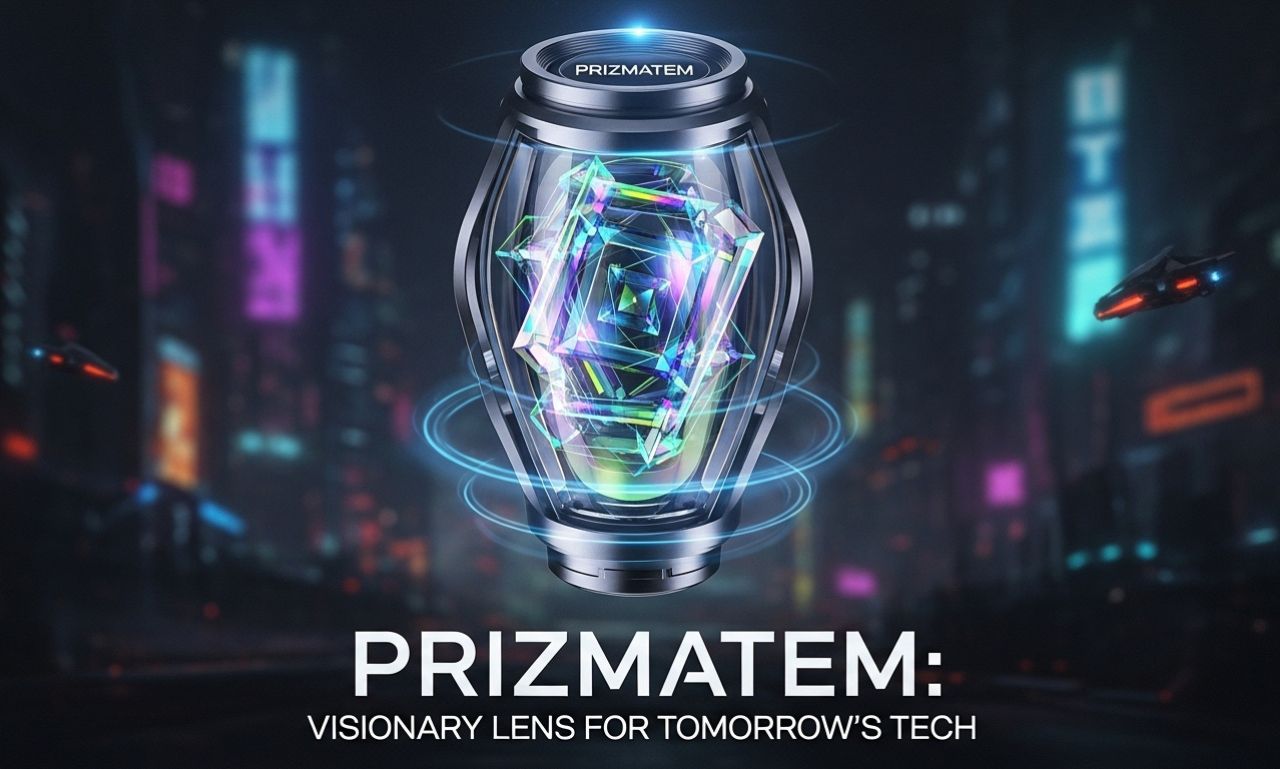In our rapidly evolving digital era, new ideas emerge at the break of dawn—among them, Prizmatem is gaining attention. Some call it a futuristic optical composite, while others describe it as a modular framework for interactive design and data. In this article, we’ll explore what Prizmatem is (in all its versions), how it works, where it’s being used, its benefits and challenges, and what its future may hold.
What Is Prizmatem?
At its heart, Prizmatem is, in fact, a blended concept—part optical system, part modular architecture, and part philosophy for viewing information or visuals through dynamic layers. In essence, it bridges the tangible and the conceptual, offering both structure and flexibility. For instance, some versions treat it as a new synthetic material that combines micro-prisms in polymer matrices, creating remarkable light-manipulating properties. Meanwhile, others interpret it as a design paradigm or digital framework that elegantly “refracts” or decomposes complex systems into manageable, interactive modules.
Moreover, the name itself fuses “prism” and “system/element,” hinting at its dual and multifaceted nature. Just as a prism breaks light into a spectrum of vivid colors, so too does Prizmatem aim to break complexity into multiple, insightful dimensions—whether of light, data, or design.
Origins and Conceptual Evolution
Although the term Prizmatem is relatively new in public discourse, its roots lie in optics, systems design, and modular frameworks. Early explorations in photonic materials, computational design, and immersive interfaces contributed to its emergence.
Over time, developers and thinkers began applying “Prizmatem” more broadly—beyond physical materials—to represent any architecture or platform that layers information (visual or conceptual) and allows interactive, adaptable behavior.
Thus, Prizmatem now straddles domains: it can be an advanced composite for optics or a metaphor (and method) for modular design.
How Prizmatem Works: Technical Perspectives
Because Prizmatem is not a singular standardized product, “how it works” depends on the context (material vs. framework). Below are two complementary views.
As an Optical Composite
In the material-based vision, Prizmatem is made of micro-prisms dispersed in a polymer or matrix. Light entering is guided, refracted, or dispersed in controlled ways. Its optical properties include high transparency, low distortion, and sometimes engineered dispersion to shape how light enters and exits.
The manufacturing process includes:
-
Dispersing micro-prisms or prismatic particles uniformly
-
Casting or molding into sheets or lenses
-
UV curing or polymerization to lock structure
-
Surface treatments (anti-scratch, anti-fog)
-
Optional embedding of conductive or sensor elements
Because of its microstructure, Prizmatem can manipulate light more flexibly than conventional glass or acrylic—allowing light to shift, diffuse, or highlight as desired.
As a Modular Framework / Digital Architecture
From the software/design side, Prizmatem is treated as a layered, modular architecture. Its key attributes:
-
Layers or modules: Each module (e.g. UI widget, image layer, data slice) is independent but interoperable.
-
Interfaces / APIs: Standardized communication between modules ensures plug & play.
-
Adaptive logic: Modules can respond to user input or environment, altering their behavior dynamically.
-
Refraction metaphor: A complex system or dataset is “refracted” into parts or perspectives, letting users navigate the components.
-
Visual layering: In interactive or AR/VR environments, different visual layers (foreground, mid, background) respond distinctly.
For example, in a Prizmatem UI system, the background, foreground, and overlay graphics all shift or respond differently to light, context, or interaction.
Core Components & Design Principles
Whether material or conceptual, Prizmatem systems typically share certain design principles:
-
Modularity: Components are loosely coupled, easy to replace or upgrade.
-
Scalability: Systems can scale by adding modules or layers.
-
Interactivity / Responsiveness: Components react in real time to stimuli.
-
Layered Abstraction: Clear separation between base layers and overlay logic.
-
Optical fidelity or clarity (for materials) or visual clarity/legibility (for design frameworks).
-
Sustainability: Reusable modules or recyclable materials where possible.
These enable designers, engineers, or creators to build flexible systems without starting from scratch each time.
Applications of Prizmatem Across Domains
Because of its hybrid nature, Prizmatem is showing up in multiple fields:
Optical & Imaging Devices
As a physical composite, Prizmatem is used in lenses, displays, light guides, and architectural glass. Its prismatic structure helps direct light, reduce glare, or shape visual output while maintaining clarity and durability.
Camera systems, AR/VR headsets, smart windows, and transparent displays are promising arenas.
UI / UX Design and Digital Products
In apps, websites, or interface systems, Prizmatem-inspired patterns create dynamic layered visuals. For example, UI elements may shift color, transparency, or position in response to user actions or device lighting.
Designers might build a “Prizmatem dashboard” that refracts data streams into modular views, letting users peel off layers for detail.
Education & Learning Tools
In the realm of e-learning or interactive educational content, Prizmatem truly stands out as a transformative tool because it enables layered modules of learning that adapt to various styles and depths. Specifically, a student can explore a concept through multiple “prismatic paths”—for example, visual, textual, quiz-based, or simulation-driven—while freely choosing how deeply to dive into each layer. As a result, learning becomes not only more flexible but also more engaging and personalized.
Furthermore, the visualization of scientific phenomena—such as light refraction itself—becomes far more intuitive when enhanced with interactive, prism-based simulations. Consequently, learners can better grasp abstract ideas by observing how light, color, and form behave dynamically, turning complex theory into an experience that feels tangible and exciting.
Data Visualization & Analytics
When dealing with complex datasets, Prizmatem frameworks can deconstruct a dataset into multiple visual slices—dimensions, clusters, temporal layers—presenting them as refracted views rather than monolithic charts.
This helps users perceive hidden patterns or trends more easily.
Creative & Immersive Media
Art installations, AR games, and immersive media experiences use Prizmatem visuals to deliver shifting light and perception. Scenes may adapt based on user movement or context, creating a living, prismatic world.
Benefits of Adopting Prizmatem
Why is Prizmatem attracting interest? Here are its advantages:
-
Greater flexibility & adaptability
-
Enhanced visual depth & interactivity
-
Efficiency via reuse
-
Better clarity & insight
-
Lightweight yet strong material use
-
Forward compatibility
These benefits make Priz-matem appealing for designers, technologists, and organizations aiming for longevity and creative flexibility.
Challenges & Limitations of Prizmatem
Despite its promise, Prizmatem also faces challenges:
-
Lack of standardization
-
Integration difficulty
-
High costs
-
Skill requirements
-
Performance trade-offs
-
User acceptance & trust
Overcoming these requires careful design, tooling, and iterative adoption.
What the Future Holds for Prizmatem
Looking ahead, these trajectories are likely:
-
Hybrid adoption of optical composites with smart modules
-
Wider tool ecosystems for AR/VR, web, and mobile
-
Standardization efforts across industries
-
Mass market use cases like smart windows and data dashboards
-
AI-driven modules that adapt over time
-
Sustainable materials and eco-friendly composites
If adopted well, Prizmatem-like systems may become as common as responsive design in today’s digital world.
Realistic Case Scenarios
-
A building uses Prizmatem glass panels that redirect sunlight dynamically to minimize glare.
-
An AR educational app uses Priz-matem layering to toggle between anatomy and physiology views.
-
A data dashboard employs Prizmatem architecture to let users peel off layers of information.
-
A camera system utilizes a prismatic composite lens to improve clarity in changing light.
Each use case demonstrates how Prizmatem bridges multiple dimensions.
Best Practices for Implementing Prizmatem
-
Start with small pilot projects.
-
Maintain clear interfaces between modules.
-
Optimize for performance and responsiveness.
-
Keep visual stability and usability in mind.
-
Document module behaviors and APIs.
-
Integrate with legacy systems carefully.
-
Gather user feedback early.
These practices reduce risks and foster innovation.
Frequently Asked Questions
What does Prizmatem exactly mean?
It merges “prism” and “system/element.” It may refer to an optical composite or a modular design framework that decomposes complexity.
Is Prizmatem a material or a software concept?
It can be either—a physical composite or a conceptual framework for layered system design.
Where is Prizmatem being used today?
It’s found in optics, UI/UX design, education, data visualization, AR/VR systems, and creative installations.
What are the main benefits of using Prizmatem?
Adaptability, modular reuse, visual depth, and improved clarity of complex data and designs.
What are its biggest challenges?
However, challenges such as standardization, integration, cost, and the learning curve for new adopters still remain significant; therefore, careful planning and gradual implementation are essential to ensure successful adoption.
Will Prizmatem replace traditional systems?
Not entirely—it enhances ex
Conclusion
Prizmatem represents more than a fleeting innovation—it’s a transformative vision for how we perceive, design, and interact with the world around us. Whether in the tangible form of an optical composite or as a conceptual framework guiding modular design, it bridges light and logic, physics and philosophy. By refracting complexity into clarity, Prizmatem empowers creators, engineers, and thinkers to build systems that are not only functional but fluid—able to adapt, evolve, and illuminate new dimensions of possibility.
As industries embrace interactivity, sustainability, and personalization, Priz-matem’s layered approach offers a timely solution. Its promise lies in balance: between beauty and precision, technology and humanity, simplicity and depth. While challenges such as cost, standardization, and integration remain, the potential rewards—greater adaptability, clarity, and creative control—are undeniable.
isting ones by adding flexibility and layered perspectives.

